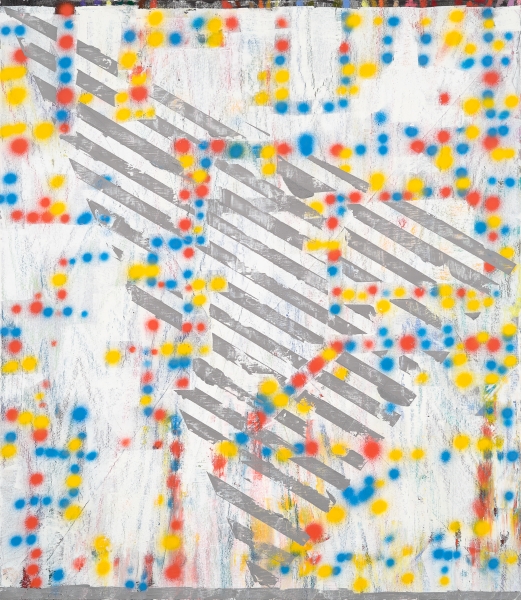“I think of each layer of paint as concealing– but only partially– an entire world behind it.”
Jason Stopa: These are clearly mixed media pieces. But I’m curious; does the term ‘mixed media’ even mean anything anymore? How do you see them?
Keltie Ferris: Actually, I don’ t ever use the term mixed media, because it’s just too vague for me. My paintings are a progression from gesso, to a colorful layer acrylic paint, to oil pastel, to oil paint. My work looks more multi-media because I use a variety of different tools, palette knife, a spray gun and brushes. To me each layer is really separate and succinct, and none of them completely cover the canvas, so you can always see the history of the painting’s making.
JS: The term multimedia seems relevant for our time too. I feel as though some of these works seem to be exploding from within it’s as if you’ve created holes within the work….points of access. Can you talk about this?
KF: Sure. I think of each layer of paint as concealing– but only partially– an entire world behind it. Each layer of paint is an insufficient mask or veil to an incredibly dynamic world of vectors and radiations. Often there is an entirely different color-world behind each layer. My paintings are very frontal and forceful, but you have the feeling that you never really entirely see all of them. They’re like most things in life — you can’t see everything all at once.
JS: I like that. Werner Herzog once said, “no one can live in an entirely illuminated room.” Which is another way of saying that we can’t know or see everything from every angle, even ourselves. How do you arrive at color and scale in the work?
KF: Since I’m 5’5″, The height of most of my larger works are 80″, which is the tallest work I can do without going up and down a stool or ladder for hours and hours. I’ve made many 80″ x 80″ square pieces, since the square has proven to be a fruitful problem for me. The smaller works, I’ve arrived at comfortable sizes, through trial and error, trying to find scales that match the tools and marks I make.
JS: These seem to be as much about the surface as they are about the physicality of the image. Can you discuss this?
KF: To me, painting is most exciting when it has some notion of touch and texture. It’s the human element of abstract work. But paintings that are just devoted to the touch of the artist— well it can lead to some sentimental places that I’m not interested in. By contrast spray paint is about a complete lack of touch. I’m painting with a machine on top of my more hand-made marks, creating the tension you’re alluding to.
JS: I sense an affinity with outer space or the way that early video games portrayed vastness, is that a correct reading? Does your work have any relationship to digital images?
KF: I’m clumsy with digital media, and was one of the last people I knew to get e-mail, to get a cell-phone, to join facebook, etc. On all accounts, I gave in, because there’s a deluge out there of digital images. I’m sure I’m very much affected by all sorts of them. Growing up, I didn’t have much access to early video games– no atari or nintendo in the house, and no quarters for the arcade. But I did want to play them. I was very interested in Astronomy as a kid and had a telescope and read Carl Sagan and Stephen Hawking, and I slept under the stars by Lake Ontario every summer. And yes, I was particularly interested in the vastness and emptiness of space more so then the stars themselves. The scale shifts are mind-boggling, to say the very least. These things seep into my paintings subconsciously, for sure, though they are far from the most pressing concerns when I am making them.
























